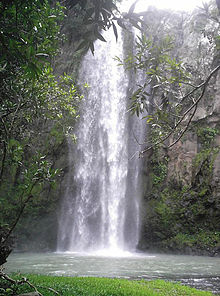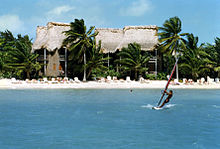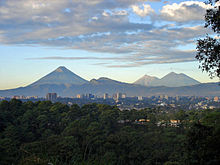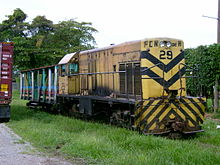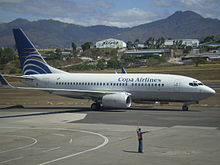
Central America
Did you know...
SOS Children volunteers helped choose articles and made other curriculum material See http://www.soschildren.org/sponsor-a-child to find out about child sponsorship.
| Central America | |
|---|---|
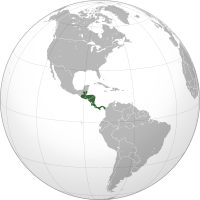 |
|
| Area | 523,780 km2 (202,233 sq mi) |
| Population | 41,739,000 (2009 est.) |
| Density | 77 /km2 (200 /sq mi) |
| Countries | 7 |
| Demonym | Central American, American |
| GDP | $107.7 billion ( exchange rate) (2006) $ 226.3 billion ( purchasing power parity) (2006). |
| GDP per capita | $2,541 ( exchange rate) (2006) $5,339 ( purchasing power parity) (2006). |
| Languages | Spanish, English, Mayan languages, Garifuna, Kriol, European languages, and many others |
| Time Zones | UTC - 6:00, UTC - 5:00 |
| Largest cities (2002) | Guatemala City San Salvador Tegucigalpa Managua San Pedro Sula Panama City San José, Costa Rica Santa Ana, El Salvador León San Miguel |
Central America (Spanish: América Central or Centroamérica) is the central geographic region of the Americas. It is the southernmost, isthmian portion of the North American continent, which connects with South America on the southeast. When considered part of the unified continental model, it is considered a subcontinent. Central America consists of seven countries: Belize, Costa Rica, El Salvador, Guatemala, Honduras, Nicaragua, and Panama. Central America is part of the Mesoamerican biodiversity hotspot, which extends from northern Guatemala through central Panama. It is bordered by Mexico to the north, the Caribbean Sea to the east, the North Pacific Ocean to the west, and Colombia to the south-east.
Central America is an area of 524,000 square kilometers (202,000 sq mi), or almost 0.1% of the Earth's surface. As of 2009, its population was estimated at 41,739,000. It has a density of 77 people per square kilometer.
History
In pre-Columbian times, the north-western areas of modern Central America were part of the Mesoamerican civilization. The Native American societies of Mesoamerica occupied the land ranging from central Mexico in the north to Costa Rica in the south. Most notable among these were the Maya, who had built numerous cities throughout the region, and the Aztecs, who created a vast empire. The pre-Columbian cultures of Panama traded with both Mesoamerica and South America, and can be considered transitional between those two cultural areas.
Following Christopher Columbus's discovery of the Americas for Spain, the Spanish sent numerous expeditions to the region, and they began their conquest of Maya lands in the 1520s. In 1540, Spain established the Captaincy General of Guatemala, which extended from southern Mexico to Costa Rica, and thus encompassed most of what is currently known as Central America, with the exception of British Honduras (present-day Belize). This lasted nearly three centuries, until a rebellion (which followed closely on the heels of the Mexican War of Independence) in 1821.
After the dissolution of Spanish authority, the former Captaincy General remained intact as part of the short-lived First Mexican Empire. Central America then emerged as a distinct political entity upon the independence of the Federal Republic of Central America a representative democracy with its capital at Guatemala City. This union consisted of the present day nations of Guatemala (which included the former state of Los Altos), El Salvador, Honduras, Nicaragua, Costa Rica (which included a region which is now part of Panama, and the Guanacaste Province which was once part of Nicaragua), and Soconusco, a portion of the modern Mexican state of Chiapas. The Republic lasted from 1823 to 1838, when it began to disintegrate due to civil wars.
Belize was contested between the Spanish Empire and the British Empire, a dispute that continued after the independence of Guatemala, who considered Belize to be a Guatemalan department. It was declared a British colony and given the name British Honduras in 1871, gaining independence as Belize in 1981.
Panama, situated in the very south of Central America on the Isthmus of Panama, has for much of its history been culturally linked to South America. Panama was a part of the Spanish Viceroyalty of New Granada, and then, following independence, became part of Gran Colombia. Only after independence from Colombia in 1903 did some begin to regard Panama as a North or Central American entity.
After two decades of internal violent conflict, social unrest, and revolutions in the 1980s and 1990s, Central America is still in a period of political transformation. Poverty, social injustice and violence are still widespread.
Geography
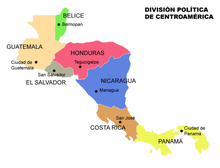
Central America has an area of 524,000 square kilometers (202,000 sq mi), or almost 0.1% of the Earth's surface. As of 2009, its population was estimated at 41,739,000. It has a density of 77 people per square kilometer or 206 people per square mile.
Physical geography
Physiographically, Central America is the tapering isthmus of southern North America, with unique and varied features extending from the north-western borders of Belize and Guatemala southeastward to the Isthmus of Panama where it connects to the Colombian Pacific Lowlands in northwestern South America. Alternatively, some physiographists sometimes locate its northern border at some point in the Isthmus of Tehuantepec, Mexico.
Central America is an area of some 524,000 square kilometres. The Pacific Ocean lies to the southwest, the Caribbean Sea lies to the northeast, and the Gulf of Mexico lies to the north. Most of Central America rests atop the Caribbean Plate.
The region is geologically active, with volcanic eruptions and earthquakes occurring frequently. The 1976 Guatemala earthquake killed 23,000 people. Managua, the capital of Nicaragua, was devastated by earthquakes in 1931 and 1972; the latter killed about 5,000 people. Three earthquakes have occurred recently in El Salvador: one in 1986, and two in 2001. An earthquake struck northern and central Costa Rica in 2009, killing at least 34 people. In Honduras, a powerful earthquake killed 7 people in 2009.
Volcanic eruptions are common in the region. In 1968 the Arenal Volcano, in Costa Rica, erupted killing 87 people as the 3 villages of Tabacon, Pueblo Nuevo and San Luis were buried under pyroclastic flows and debris. Fertile soils from weathered volcanic lavas have made it possible to sustain dense populations in the agriculturally productive highland areas.
Central America has many mountain ranges; the longest are the Sierra Madre de Chiapas, the Cordillera Isabelia and the Cordillera de Talamanca. Between the mountain ranges lie fertile valleys that are suitable for the people; in fact most of the population of Honduras, Costa Rica and Guatemala live in valleys. Valleys are also suitable for the production of coffee, beans and other crops.
Biodiversity

Central America is part of the Mesoamerican Biodiversity hotspot, boasting 7% of the world's biodiversity. As a bridge between North and South America, Central America has many species from the Nearctic and the Neotropic ecozones. However the southern countries (Costa Rica and Panama) of the region have more biodiversity than the northern countries (Guatemala and Belize), meanwhile the central countries (Honduras, Nicaragua and El Salvador) have least biodiversity. The table shows current statistics for the seven countries:
| Country | Amphibians | Birds | Mammals | Reptile | |||
|---|---|---|---|---|---|---|---|
| 46 | 544 | 147 | 140 | 877 | 2894 | 3771 | |
| 183 | 838 | 232 | 258 | 1511 | 12119 | 13630 | |
| 30 | 434 | 137 | 106 | 707 | 2911 | 3618 | |
| 133 | 684 | 193 | 236 | 1246 | 8681 | 9927 | |
| 101 | 699 | 201 | 213 | 1214 | 5680 | 6894 | |
| 61 | 632 | 181 | 178 | 1052 | 7590 | 8642 | |
| 182 | 904 | 241 | 242 | 1569 | 9915 | 11484 |
Demographics
| Name of territory, with flag |
Area (km²) |
Population (July 2009 est.) |
Population density (per km²) |
Capital | Official language |
HDI |
|---|---|---|---|---|---|---|
| 22,966 | 307,000 | 13 | Belmopan | English | 0.694 High | |
| 51,100 | 4,196,000 | 82 | San José | Spanish | 0.744 High | |
| 21,040 | 6,163,000 | 292 | San Salvador | Spanish | 0.674 Medium | |
| 108,890 | 14,027,000 | 129 | Guatemala City | Spanish | 0.574 Medium | |
| 112,090 | 7,466,000 | 67 | Tegucigalpa | Spanish | 0.625 Medium | |
| 130,373 | 5,743,000 | 44 | Managua | Spanish | 0.589 Medium | |
| 78,200 | 3,454,000 | 44 | Panama City | Spanish | 0.768 High | |
| Total | 523,780 | 41,356,000 | 80 | - | - |
| City | Country | Population | Census Year | % of National population |
|---|---|---|---|---|
| Guatemala City | Guatemala | 3,700,000 | 2010 | 26% |
| San Salvador | El Salvador | 2,415,217 | 2009 | 39% |
| Managua | Nicaragua | 2,408,000 | 2012 | 42% |
| San Jose | Costa Rica | 1,715,485 | 2006 | 37% |
| San Pedro Sula | Honduras | 1,542,364 | 2010 | 21% |
| Tegucigalpa | Honduras | 1,324,000 | 2010 | 18% |
| Panamá City | Panama | 1,272,672 | 2010 | 37% |
Politics
Central American Integration
Sistema de Integración Centroamericana
Central American Integration System
| Area | 560,988 km² |
|---|---|
| Population | 50,807,778 hab. |
| Countries |
Central America is currently undergoing a process of political, economic and cultural transformation that started in 1907 with the creation of the Central American Court of Justice.
In 1951 the integration process continued with the signature of the San Salvador Treaty, which created the ODECA, the Organization of Central American States. However, the unity of the ODECA was limited by conflicts between several member states.
In 1991, the integration agenda was further advanced by the creation of the SICA, Sistema para la Integración Centroamericana or System for the Central American Integration. The SICA provided a clear legal basis to avoid disputes between the member states. The SICA membership includes the 7 nations of Central America plus the Dominican Republic, a state that is traditionally considered part of the Caribbean.
On December 6, 2008 SICA announced an agreement to pursue a common currency and common passport for the member nations. No timeline for implementation was discussed.
Central America already has several supranational institutions such as the Central American Parliament, the Central American Bank for Economic Integration and the Central American Common Market.
On July 22, 2011 President Funes of El Salvador became the first president pro tempore to the SICA. El Salvador also became the headquarters of SICA in the inauguration of a new building.
Foreign Relations
Until recently, all Central American countries have maintained diplomatic relations with Taiwan instead of China. President Oscar Arias of Costa Rica, however, established diplomatic relations with China in 2007, severing formal diplomatic ties with Taiwan.
Infrastructure

Roads
The Pan-American Highway runs through Central America, and except for an 87 kilometres (54 mi) rainforest break, called the Darién Gap, the road links the mainland nations of the Americas in a connected highway system. According to Guinness World Records, the Pan-American Highway is the world's longest "motorable road". However, because of the Darién Gap, it is not possible to cross between South America and Central America by traditional motor vehicle.
Rail
- Belize: see Rail transport in Belize
- Costa Rica: see Rail transport in Costa Rica
- El Salvador: see Rail transport in El Salvador
- Guatemala: see Rail transport in Guatemala
- Honduras: see Rail transport in Honduras
- Nicaragua: see Rail transport in Nicaragua
- Panama: see Rail transport in Panama
Airlines
Usage
"Central America" may mean different things to various people in the world based upon different contexts:
- In English-speaking countries, Central America is usually considered a region of the North American continent. Geopolitically, it usually comprises seven countries – Belize, Guatemala, El Salvador, Honduras, Nicaragua, Costa Rica, and Panama. Mexico, in whole or in part, is sometimes included, regardless of correctness, by Britons. Some geographers include the five states of Campeche, Chiapas, Tabasco, Quintana Roo, and Yucatán, together representing 12.1% of the country's total area.
- In Latin America, Iberia, and some other parts of Europe, the Americas are considered to be a single continent called America, and Central America is considered a distinct region of this continent and not a part of North America. In Ibero-America, the region is defined as seven nations – Belize, Guatemala, El Salvador, Honduras, Nicaragua, Costa Rica, and Panama – and may occasionally include Mexico's southernmost region. Geopolitically, Mexico is considered part of North America.
- Occasionally, regardless of correctness, the term Central America is used synonymously with Middle America. Among some German geographers, Mittelamerika may be used to refer to the territories on the Central American isthmus.
- In German, Zentralamerika may be used to refer to the territories on the Central American isthmus.
- The UN geoscheme defines the region as all states of mainland North America south of the United States; conversely, the European Union excludes Belize and Mexico from its definition of the region.


